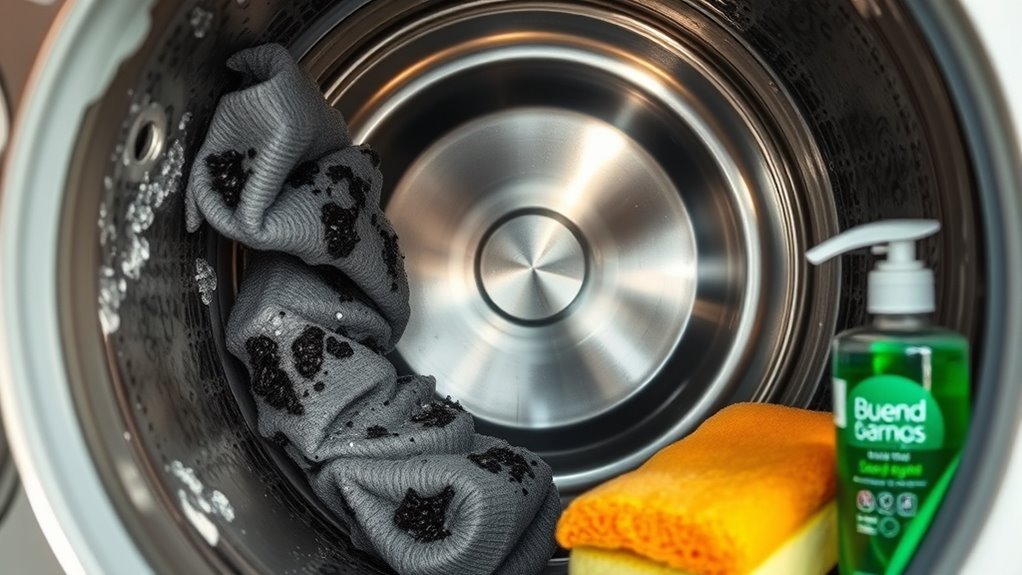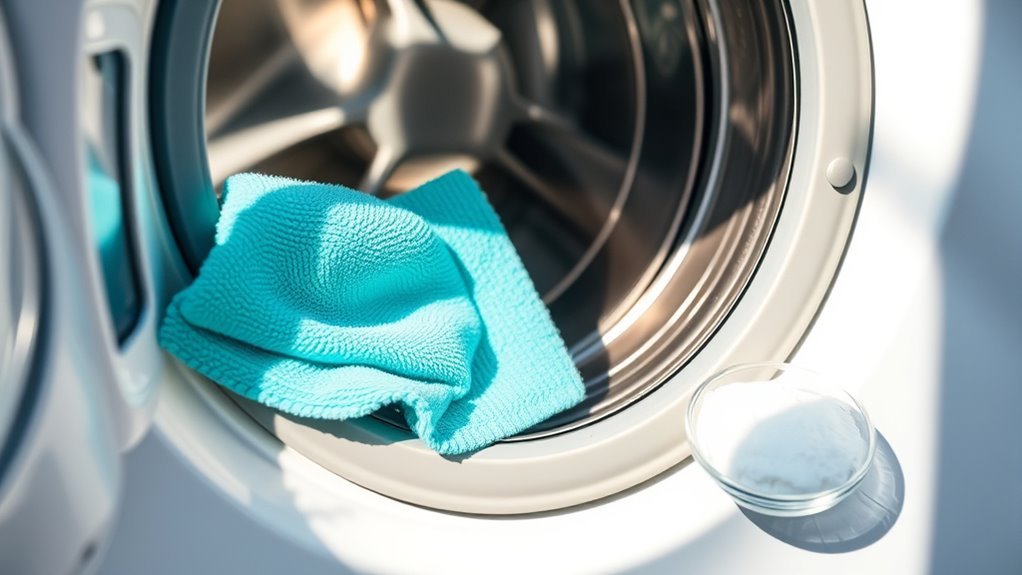Cleaning Techniques for Washer Owners
To keep your washer residue-free, first inspect for white films or odors indicating buildup. Clean the drum and rubber seal with a vinegar-water mix, scrubbing stubborn spots with baking soda paste. Remove and soak the detergent dispenser regularly, scrubbing corners to avoid clogs. Leave the door open after cycles to prevent mold, and run a monthly hot-water maintenance wash using vinegar or cleaner. Regular hose and lint filter checks help maintain performance. Follow these methods to enhance your washer’s longevity and efficiency.
Identifying Common Washer Residues

How can you tell if your washer has residue buildup? First, inspect the drum and detergent dispenser for visible white or gray films, which often indicate detergent residue accumulation. A musty odor after a cycle also suggests leftover fabric softener or detergent residues trapped inside. When clothes feel stiff or have a dull appearance, it’s a sign residue is not rinsing out properly. To confirm, run a rinse cycle without laundry and check for suds or filmy deposits. Keep an eye on the inside door seal; residues can collect there, affecting seal integrity and cleaning efficiency. By detecting these signs early, you maintain your washer’s performance and extend your freedom from frequent maintenance, ensuring cleaner clothes with every wash.
Cleaning the Washer Drum and Seal
You’ll need to remove residue buildup inside the drum and carefully clean mold and mildew from the door seal to keep your washer functioning properly. Use a suitable cleaner and a soft cloth or brush to reach all crevices without damaging the surfaces. Regular maintenance of the door seal prevents odor and leaks, ensuring peak washer performance.
Removing Residue Buildup
Although washers are designed to handle moisture, residue buildup in the drum and seal can impair performance and cause odors. To remove this buildup effectively, start by wiping the drum and rubber seal with a microfiber cloth dampened with a mixture of equal parts water and white vinegar. This solution breaks down detergent and fabric softener deposits, aiding residue prevention. For stubborn stains, apply a paste of baking soda and water directly to affected areas, let it sit for 15 minutes, then scrub gently with a soft brush. Run an empty hot water cycle with two cups of white vinegar afterward to flush out loosened residue. Regularly performing these steps will maintain your washer’s efficiency and extend its lifespan, freeing you from frequent repairs and unpleasant smells.
Cleaning Mold and Mildew
Residue buildup can create an environment where mold and mildew thrive, especially in the washer drum and rubber seal. To guarantee effective mold prevention and mildew cleaning, you need to act methodically. Start by running a hot water cycle with a cup of white vinegar or a commercial washing machine cleaner. Next, focus on the rubber seal—wipe it thoroughly with a solution of equal parts water and vinegar or a mild bleach solution. Remember to dry the seal completely after cleaning to prevent moisture retention. For ongoing mold prevention:
- Keep the washer door open after use to allow air circulation
- Remove wet clothes promptly
- Clean detergent dispensers regularly
- Schedule monthly deep clean cycles
These steps will keep your washer fresh and mold-free, granting you laundry freedom.
Maintaining Door Seal
The door seal plays a critical role in preventing leaks and maintaining your washer’s efficiency. For effective door seal maintenance, regularly inspect the rubber gasket for cracks, debris, or mold buildup. Wipe it down after each use with a damp cloth and mild detergent to remove residue that can degrade the seal over time. Confirm the door is left open to allow the seal to dry thoroughly, preventing moisture accumulation that leads to mold and damage. Periodically, perform a deep clean by applying a diluted vinegar solution or a specialized washer cleaner to the seal, scrubbing gently with a soft brush. These steps are essential for preventing leaks and preserving your washer’s performance, giving you the freedom to rely on a clean, efficient appliance without frequent repairs.
Using Vinegar and Baking Soda for Deep Cleaning
You can use vinegar to effectively break down mineral deposits and disinfect your washer. Adding baking soda helps neutralize odors and enhances the cleaning action when combined with vinegar. Follow a specific process to apply both substances for a thorough deep clean.
Benefits of Vinegar Cleaning
Although commercial cleaners are available, using vinegar combined with baking soda offers an effective and natural solution for deep cleaning your washer. The vinegar benefits are substantial: it acts as a powerful disinfectant and dissolves mineral deposits, while being an eco friendly cleaner that won’t harm your machine or the environment. By incorporating vinegar into your cleaning routine, you maintain washer efficiency and extend its lifespan.
Key advantages include:
- Eliminates odor-causing bacteria and mold
- Breaks down soap scum and hard water buildup
- Safe for all washer types, including HE models
- Reduces chemical exposure for a healthier household
Using vinegar empowers you to clean thoroughly and sustainably, giving you freedom from harsh chemicals without sacrificing performance.
Baking Soda Cleaning Process
Two simple ingredients—baking soda and vinegar—combine to create a highly effective cleaning process for your washer. Start by adding 1/2 cup of baking soda directly into the drum. Baking soda benefits include neutralizing odors, loosening grime, and gently scrubbing surfaces without damage. Next, pour 2 cups of vinegar into the detergent compartment. Run a hot water cycle to activate the mixture, which breaks down residues and mineral deposits. If you don’t have baking soda, common baking soda alternatives like washing soda or borax can be used, but adjust quantities accordingly, as they vary in strength. This routine guarantees your washer stays fresh and efficient, giving you the freedom to maintain cleanliness with minimal effort and maximum results.
Combining Vinegar and Baking Soda
Combining 1/2 cup of baking soda with 2 cups of vinegar creates a powerful chemical reaction that enhances your washer’s deep cleaning process. This mixture leverages the vinegar benefits—natural acidity to dissolve mineral buildup—and baking soda’s mild abrasiveness to lift grime effectively. To apply this method correctly, follow these steps:
- Add baking soda directly into the drum.
- Pour vinegar into the detergent dispenser.
- Run a hot water cycle without clothes.
- Allow the washer to rest for an hour post-cycle to maximize cleaning.
This technique frees you from harsh chemicals while maintaining your washer’s efficiency. By integrating these natural agents, you guarantee thorough sanitation and odor elimination, extending your machine’s lifespan with minimal effort.
Maintaining the Detergent Dispenser
Because detergent dispensers are prone to residue buildup, you should clean them regularly to confirm ideal detergent flow and prevent mold growth. Start by removing the dispenser drawer completely, following your washer’s manual if needed. Soak the drawer in warm water mixed with a mild detergent to break down residues from various detergent types, including powders and liquids. Use a soft brush to scrub all compartments thoroughly, paying close attention to corners where buildup accumulates. Rinse with clean water and dry the components fully before reinserting them. Regular dispenser cleaning confirms the correct amount of detergent dispenses, optimizing wash performance and prolonging your washer’s life. Incorporate this maintenance into your routine every few weeks, especially if you frequently switch detergent types or notice inconsistent dispensing.
Preventing Mold and Mildew Buildup

Although modern washers are designed to minimize moisture retention, mold and mildew can still develop in damp, enclosed areas if proper precautions aren’t taken. To effectively implement mold prevention strategies and mildew removal techniques, you need to focus on ventilation and moisture control. Here’s what you can do:
- Leave the washer door open after each cycle to allow air circulation.
- Wipe down seals and gaskets regularly to remove trapped moisture.
- Use high-efficiency detergents to reduce residue buildup that fosters mold growth.
- Run a monthly cleaning cycle with specialized washer cleaner or diluted bleach.
Regular Washer Maintenance Tips
To keep your washer operating efficiently and extend its lifespan, you should perform regular maintenance tasks beyond just cleaning mold and mildew. Start by inspecting and cleaning the detergent dispenser monthly; residue buildup can impair washer efficiency and compromise laundry hygiene. Run a maintenance wash using a high-temperature cycle with a washer cleaner or vinegar to eliminate internal deposits. Check and clean the lint filter regularly to prevent blockages. Inspect hoses for cracks or leaks every few months to avoid water damage. Leave the door open after each cycle to allow air circulation, reducing moisture buildup. By following these precise maintenance steps, you’ll optimize washer efficiency, guarantee superior laundry hygiene, and enjoy the freedom of a reliable, long-lasting appliance.
Frequently Asked Questions
Can I Use Bleach Instead of Vinegar for Washer Cleaning?
You might think bleach and vinegar serve the same purpose, but they don’t. While bleach is a strong disinfectant, it can damage washer components over time. Vinegar, a gentler bleach alternative, effectively breaks down mineral deposits without risking corrosion. For ideal washer maintenance, avoid harsh chemicals that limit your freedom to use your machine confidently. Instead, choose vinegar or specialized cleaners designed to preserve your washer’s longevity and performance.
How Often Should I Replace My Washing Machine Hoses?
You should replace your washing machine hoses every 3 to 5 years to guarantee peak performance and safety. Regular hose maintenance includes inspecting for cracks, bulges, or leaks. Don’t wait for visible damage; hose lifespan can be shorter due to water pressure and temperature fluctuations. By proactively maintaining and replacing hoses within this timeframe, you reduce the risk of water damage and enjoy the freedom of worry-free laundry sessions.
Is It Safe to Wash Delicate Fabrics in a Front-Loader?
You want to keep your delicate fabrics safe, so you wonder if a front loader is up to the task. It is. Front loader performance excels in gentle agitation and controlled spin cycles, reducing wear on delicate fabrics. Just select the appropriate cycle, usually labeled “delicates” or “hand wash,” and use cold water with mild detergent. This guarantees thorough cleaning without compromising fabric integrity, giving you freedom to wash confidently.
What Is the Best Water Temperature for Cleaning Heavily Soiled Clothes?
When cleaning heavily soiled clothes, you’ll want to use hot water because it’s more effective at breaking down dirt, oils, and stains. Hot water activates detergents better, ensuring a thorough clean. Avoid cold water for heavily soiled items, as it may not dissolve grime fully. However, always check your garment’s care label first. Using hot water wisely lets you free your clothes from tough dirt without damaging the fabric.
How Do I Troubleshoot a Washer That Won’T Drain Properly?
If your washer won’t drain properly, start by checking for drainage issues like clogged hoses or blocked pumps. Unplug the washer, then inspect and clean the filter—it often traps debris causing backups. Make sure the drain hose isn’t kinked or elevated above the washer’s outlet. Running a short cycle after clearing these should restore proper drainage. Regular filter maintenance prevents future problems, giving you freedom from unexpected stoppages.






